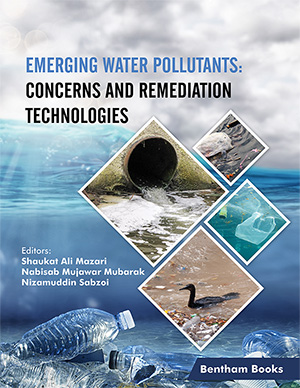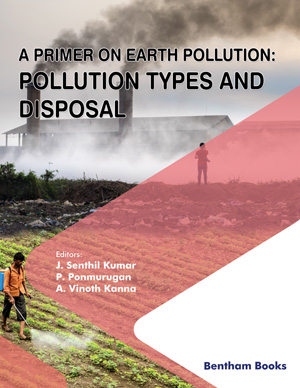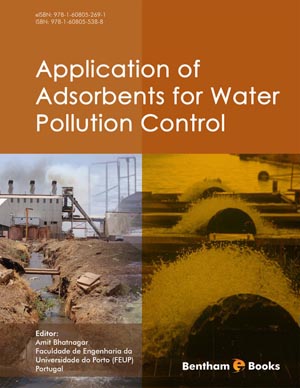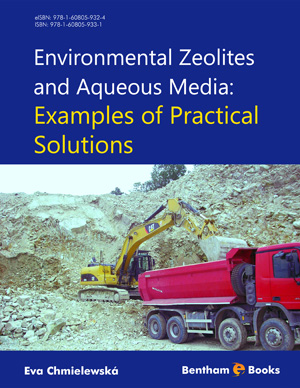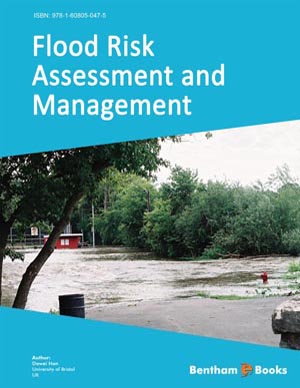Preface
Page: i-iii (3)
Author: Shaukat Ali Mazari, Nabisab Mujawar Mubarak and Nizamuddin Sabzoi
DOI: 10.2174/97897815040739122010001
Emerging Water Pollutants, their Toxicities, and Global Legislations
Page: 1-27 (27)
Author: Shoaib Ahmed, Fahad Saleem Ahmed Khan, Nabisab Mujawar Mubarak*, Yie Hua Tan, Rama Rao Karri, Mohammad Khalid, Rashmi Walvekar, Ezzat Chan Abdullah, Shaukat Ali Mazari and Sabzoi Nizamuddin
DOI: 10.2174/97897815040739122010003
PDF Price: $30
Abstract
Emerging pollutants (EPs) in the environment have become a significant
source of pollution and cause of serious concern for the ecosystem and human health.
Although during the recent decades, extensive research has been performed worldwide
for the detection and analysis of EPs, continuous refinement, and development of
specific analytical techniques; a great number of undetected EPs still need to be
investigated in different components of the ecosystem and biological tissues.
Therefore, this chapter provides extensive reviews of several emerging pollutants
reported around the globe along with their physiochemical properties and potential
ecological impacts. Moreover, formulated legislations and policy regulations for the
monitoring of EPs are also discussed in this chapter.
Emerging Water Pollutants from Pharmaceuticals and Personal Care Products
Page: 28-52 (25)
Author: Pranta Barua*, Joydeb Babu Pranta and Nazia Hossain*
DOI: 10.2174/97897815040739122010004
PDF Price: $30
Abstract
Pharmaceuticals and personal care products (PCPs) are chemically modified
products mostly used for beauty, cleaning, or health, such as disinfectants, fragrances,
insect repellents, ultraviolet (UV) filters, and others. Due to the contamination caused
by these chemically amended PCPs, water pollution has appeared as a hazardous
condition for the water treatment and supply sector. A recent concern is that when these
chemical compounds combine with water, they act as water pollutants and harm
aquatic lives and the survival of human lives. Nowadays, the concern of water pollution
by these chemicals is confined to water treatment complexities this contamination is
leaving adverse effects on the environment. Most of these water pollutants borne by
sewage effluents through wastewater plants develop because of the insufficient
removal from treatment plants. Therefore, the emerging water pollutants caused by
PCPs are responsible for environmental pollution. Hence, this chapter emphasized the
state-of-the-art global application of PCPs, the mechanism of water pollution by PCPs,
possible biohazards, and negative impacts on the environment. Besides that, various
types of PCPs, along with the most applied chemical compounds in PCPs, have been
discussed in this chapter. To minimize the contamination, suitable removal methods to
enhance the removal efficacy have been discussed. The chapter also presents a future
perspective for reducing the PCP contamination of surface water with cutting-edge
technologies and wastewater treatment.
Emerging Water Pollutants from Food and Packaging Industry
Page: 53-76 (24)
Author: Muhammad Ashar Ayub, Muhammad Zia ur Rehman*, Muhammad Umair, Sana Rana, Zahoor Ahmad, Nimra Khalid, Hafiza Salma and Husnain Zia
DOI: 10.2174/97897815040739122010005
PDF Price: $30
Abstract
Rapid industrialization and continuous mechanization of the food industry have increased waste production which is a source of various kinds of contaminants especially emerging water pollutants (EWPs). The industry of food (agriculture and processed food) and packaging industry are major sources of these emerging pollutants. Agrochemicals are also a source of pollutants which are contaminating the food chain and underground water. The dairy and meat industries are source of excess antibiotics, lactating hormones, medicines (via exudates and effluents), animal fats, acids, sludge, organic compounds and persisting chemicals in meat and milk. The food processing industry can also contribute various pollutants, like dyes, preservatives, sanitizing and disinfecting agents, as well as alcoholic and phenolic residues from the beverage and wine industries.The food packaging industry is also a major source of food preservatives, dyes, glue, and non-recyclable/one-time-use materials (plastic and polystyrene), which can be broken down into micro/nano plastics leading their way to water reserves and ultimately to the human food chain. Effluents of the food and packaging industry are rich in organic material and can support the growth of various pathogenic bacteria and fungi which can become a source of EWPs and can compromise human health that’s why comprehensive information about these pollutants is needed. Keeping in mind all of these aspects present draft is compiled. This chapter covers various aspects of emerging water pollutants released from foodrelevant industries.
Engineered Nanomaterials as Emerging Water Pollutants
Page: 77-99 (23)
Author: Abdul Sattar Jatoi*, Shuakat Ali Mazari, Zubair Hashmi, Shoaib Ahmed, Nabisab Mujawar Mubarak, Rama Rao Karri, Nizamuddin Sabzoi, Rashid Abro, Asif Shah, Abdul Qayoom Memon, Abdul Karim Shah and Atta Muhammad
DOI: 10.2174/97897815040739122010006
PDF Price: $30
Abstract
Nanotechnology has many advantages, and its applications are spread to
every field, from engineering to medicine and space to agriculture. Owing to the
immense advantages of nano-size particles, nano-based materials are widely applied in
wastewater treatment. These nanomaterials are developed and utilized in different
sizes, shapes, and chemical compositions. These nanomaterials are characterized by
their unique physical, chemical and biological properties. Besides the immense benefits
of nanomaterials, they also have few environmental implications. This chapter presents
the pros and cons of nanomaterials and their implications on the environment. Further,
the effect of various nanomaterials on the aquatic environment, including the behaviour
and toxicity on the aquatic ecosystem, is discussed. Finally, future directions to
minimize the toxic effect of nanomaterials on the aquatic ecosystem and the need for
improvement in the nanomaterials are presented.
Emerging Water Pollutants from Industrial Processes
Page: 100-118 (19)
Author: N.W.C. Jusoh*, N.F. Jaafar, A. Masudi and P.Y. Liew
DOI: 10.2174/97897815040739122010007
PDF Price: $30
Abstract
The widespread problem of water pollution endangers human health. Every
year unsafe water causes more deaths than war and integrates all other forms of
violence. Industrial activities create a large source of emerging water pollutants that are
highly harmful to humans and the environment. This leads to increasing concern for the
possible ecological impact of these pollutants on the environment. This chapter
identifies various emerging water pollutants produced from different industrial
processes (e.g., petrochemical production, textile, paper and pulp, semiconductor/
electroplating, and metal production). The possible route of pollution formation is
discussed in this chapter. In addition, the impact of the produced water pollutants on
the environment and health has been elucidated. Furthermore, the concerns of emerging
contaminants remain a moving subject as the new pollutants continuously are being
produced in industrial processes. In response, an insight into the challenges of
minimizing water pollution is also focused on mutual benefit.
Risk Assessment of Emerging Water Pollutants
Page: 119-143 (25)
Author: Zahra Zahra*, Zunaira Habib and Brian Moon
DOI: 10.2174/97897815040739122010008
PDF Price: $30
Abstract
A complex mixture of pollutants in wastewater runs down from different sources into the aquatic environment, with potential hazards to aquatic organisms, human health, and the environment. Among these water pollutants, F−, NO3 −, and heavy metals (Cd, Pb Hg, Zn, Cr, Ni, As, etc.) are considered conventional pollutants, whereas nanomaterials, pharmaceutical compounds, personal care products, pesticides, endocrine disrupting compounds (EDCs), artificial sweeteners, surfactants, etc. are known as emerging water pollutants. This cocktail of water pollutants in the aquatic ecosystem is a real danger, leading to detrimental effects. This chapter discussed the environmental risk assessment (ERA) of the emerging water pollutants, especially the nanomaterials. The ERA of emerging pollutants will help indicate potential risks associated with these substances, highlighting the importance of their hazard identification, dose-response and exposure assessment, and risk characterization. This information will give insights into the recent findings related to the pollutants’ effects and their assessment approach.
Fate of Emerging Water Pollutants
Page: 144-177 (34)
Author: Muhammad Ashar Ayub, Muhammad Zia ur Rehman*, Wajid Umar, Mujahid Ali and Zahoor Ahmad
DOI: 10.2174/97897815040739122010009
PDF Price: $30
Abstract
Emerging pollutants reflect a major global water quality problem. When
these compounds enter the environment, they cause significant environmental threats to
aquatic and human health. Emerging water pollutants (EWPs) include new materials
with no regulatory status butthey can adversely affect the environment and human
health. Emerging water contaminants can be biological or synthetic that remain
unregulated, and pose a potential threat. Major classes of such pollutants are
pharmaceuticals, agro-chemicals, endocrine-disrupting chemicals (EDCs), industrial
wastes, livestock wastes, synthetic nanomaterials, and petroleum products. These
pollutants can enter the environment through numerous sources and pose severe threats
to soil organisms, agriculture, aquatic life, and humans. Pharmaceutical waste,
industrial effluents, cosmetic and cleansing products, household sanitation, discharge,
and synthetic NPs enter water channels, agro-ecosystem, underground water (via
seepage), etc., posing a serious threat. These EWPs have different unknown and known
effects on animals, plants, and human health, which must be viewed positively. This
chapter summarizes the sources and classification of EWPs, their entry into the
environment, and their fate. A major focus will be on the end sink of pollutants with
potential threats and risk evaluation for plants and human health.
Lifecycle Assessment of Emerging Water Pollutants
Page: 178-203 (26)
Author: Nisa Waqar-Un*, Luqman Riaz, Aansa Rukya Saleem, Samia Qadeer, Tahir Hayat Malik, Nazneen Bangash, Talat Ara and Audil Rashid
DOI: 10.2174/97897815040739122010010
PDF Price: $30
Abstract
Emerging pollutants (EPs), also known as contaminants of emerging
concern, include pharmaceuticals and personal care products (PPCPs), surfactants,
plasticizers, pesticides, etc., and the pharmaceuticals and personal care products are
extensively used for therapeutic and non-therapeutic purposes in health care settings,
livestock industry, and agriculture. Consumption and production of PPCPs have
generated significant quantities of toxic waste in affluent entering the water streams,
which poses a risk to aquatic life, public health, and the ecosystem. Given the potential
toxicity impacts, continuous exposure to PPCPs is of critical concern. However, the
concentrations of PPCPs in the environment are low. Efforts are being made to
synergize efficient and cost-effective PPCPs removal technologies to remediate these
pollutants from the environment. Still, the success rate is low because of their low
concentration (ppb or ppt) and complex chemical structure. Common wastewater
treatment technologies are not found efficient enough to attain their complete
elimination from the aquatic matrix. Concurrently, ecological problems associated with
water quality and aquatic life are aggravated in the prone areas, particularly in the
developing world, owing to inadequate monitoring, data management, and treatment
facilities. The lifecycle assessment (LCA) is an effective tool for efficient monitoring,
quantification, and damage incurred by various stages from production to possible
disposal. This chapter summarizes the LCA process of PPCPs, including the release
and accumulation, to examine the impacts and associated risks to water quality, the
aquatic environment, and ultimately human beings. Furthermore, the deep insight of LCA will help to understand the kinetics of pollutants in environment exchange pools
and help fill the existing knowledge gaps that would be a certain better step for
management and remediation.
Conventional Methods for Removal of Emerging Water Pollutants
Page: 204-228 (25)
Author: Manoj Tripathi* and Akanksha Verma
DOI: 10.2174/97897815040739122010011
PDF Price: $30
Abstract
Water is essential for life and no creature can survive without clean and usable water. Most water is unusable as it contains salts and many other organic and inorganic impurities. Without taking these impurities out, the water available to us cannot be used. Different techniques can be adapted to purify the water and make it usable. The selection of the water purification technique can be made depending upon the water contamination, its loading, and other parameters. Based on the contamination and other parameters, chemical or physical techniques for water purification can be applied. Disinfection, desalination, coagulation, and chemical precipitation are common chemical methods used for water purification. For adsorption, membrane filtration is used to filter the pollutant out physically. Various char-based materials are synthesized and used for water purification using the adsorption route. Highly porous char materials can contain the contaminants into their pores and allow the clean water to pass through. The overflow of the adsorbent with the pollutant can be solved by using magnetic biochar as the contaminants can be taken out of the magnetic charbased adsorbent and reused. Thus, the process becomes more effective and efficient. The chapter talks about these processes and their limitations, and advantages over the others. It also describes different types of materials used for the water purification processes.
Advanced Membrane Processes for the Removal of Emerging Water Pollutants
Page: 229-267 (39)
Author: Arbab Tufail*
DOI: 10.2174/97897815040739122010012
PDF Price: $30
Abstract
This chapter demonstrates the source and pathway of emerging contaminants (ECs) and their removal by advanced membrane technologies. These ECs are naturally occurring or synthetic organic pollutants, including pharmaceuticals and personal care products, estrogens, industrial chemicals, UV filters, pesticides, and endocrine-disrupting chemicals ubiquitously detected in wastewater and wastewaterimpacted surface waterbodies. Emerging contaminants have detrimental effects on aquatic flora and fauna and may affect human health. Due to the persistent nature of ECs, they are resistant to conventional wastewater treatments. Moreover, different physicochemical processes have shown ineffectiveness for the removal of ECs. Therefore, there is a need for robust wastewater treatment processes such as advanced membrane technologies that can effectively remove these ECs. Advanced membrane technologies use membranes that separate ECs from the solution and include forward osmosis, reverse osmosis, nanofiltration, ultrafiltration, microfiltration, catalytic membranes, and membrane bioreactors. Briefly, the focus of this chapter is to provide an overview of different membrane separation technologies and illustrate various examples of ECs removal.
Osmotic and Filtration Processes for the Removal of Emerging Water Pollutants
Page: 268-289 (22)
Author: Kamran Manzoor and Sher Jamal Khan*
DOI: 10.2174/97897815040739122010013
PDF Price: $30
Abstract
Emerging pollutants (EPs) in water and wastewater are one of the global
water quality challenges and have substantially adverse and serious effects on
ecosystems and human health. However, the presence of these EP’s is generally in
minute quantities ranging from microgram per liter to nanogram per liter in the
environment. These emerging water pollutants may contain endocrine-disrupting
compounds (EDCs), personal care and pharmaceutical products, surfactants, hormones,
steroids, etc. EPs can also be generated from the synthesis of new chemicals and their
by-products in industries. Considering the potential impact of these EPs, an appropriate
and effective wastewater treatment approach is needed, which can remove the wide
variety of these EPs. Membrane technologies have gained more attention in water
filtration processes as membrane technology can remove the emerging water and
wastewater pollutants with different membranes. The presence of the membrane barrier
is one of the main advantages of the membrane filtration process, which offers a wide
variety of supplementary adsorption mechanisms for EPs. The pressure-driven
membrane filtration processes include micro-filtration (MF), nano-filtration (NF),
ultra-filtration (UF), and reverse osmosis (RO). In contrast, the osmotically driven
membrane filtration processes (ODMFP) include pressure retarded osmosis (PRO) and
forward osmosis (FO) only. This chapter will review the major characteristics,
advancements, and principles of NF, RO, ODMFP, and other emerging membrane
filtration technology for treating EPs in water and wastewater
Catalytic Processes for Removal of Emerging Water Pollutants
Page: 290-325 (36)
Author: Shabnam Taghipour*, Marziyeh Jannesari*, Behzad Ataie-Ashtiani, Seiyed Mossa Hosseini and Mohammadhossein Taghipour
DOI: 10.2174/97897815040739122010014
PDF Price: $30
Abstract
An unprecedented increase in urbanization and industrialization ignited by
an upsurge in the development of consumer goods. This has been steadily destroying
the environmental balance and ecosystem and diminishing the water quality.
Inevitably, we are facing one of the biggest challenges of the time, which needs to be
resolved with proper remediation strategies to provide clean water as one of the
essential components for human beings and agriculture, livestock, and several
industrial survivals. With the growing demand for water and sustainable improvement,
utilizing unconventional water supplies such as contaminated fresh water, brackish
water, and wastewater is required. Although some of the traditional water treatment
and purification methods still retain their importance. However, there is a need to
provide faster and more efficient technologies beyond conventional methods for
treating various contaminated water sources, including emerging pollutants. Recently,
catalytic processes such as ozonation and electrocatalysis, including electrocatalytic
oxidation, electro-Fenton process, photo electro-Fenton process, photocatalysis, and
reduction by hydrodehalogenation, exhibited unique features and have opened wide
opportunities in the field of water treatment. This chapter describes various types of emerging contaminants, their effect on human health and the ecosystem, and analytical
methods of ECs quantification. Moreover, the features, mechanisms, and potential
applications of catalytic processes in treating emerging pollutants are discussed in
detail.
Integrated Processes for Removal of Emerging Water Pollutants
Page: 326-345 (20)
Author: Muhammad Saud Baig, Siraj Ahmed, Ghulam Mujtaba*, Muhammad Rizwan, Naveed Ahmed and Sheeraz Ahmed
DOI: 10.2174/97897815040739122010015
PDF Price: $30
Abstract
As the world advances rapidly in technology, industries are experiencing
rampant growth, and the healthcare sector is reaching new heights; however, novel
challenges are emerging that threaten humanity in entirely new ways. Industrial
development, large-scale urbanization, and hazardous effluent from healthcare facilities
increase concentrations of emerging pollutants in our surface waters. Emerging
pollutants have puzzled the researchers as they are relatively in smaller quantities than
other pollutants, yet they pass through the conventional water treatment processes
unscathed. Innovative integrated methods must be employed to enhance the water
quality by significantly removing these persistent emerging pollutants. This chapter
dives deeper into modern research to remove emerging water pollutants effectively.
Integrated methods such as integrated electrocoagulation, activated sludge with
membrane technology, and construction of wetlands are thoroughly presented.
Introduction
This book examines a wide range of emerging sources off water pollution. It consists of thirteen chapters dedicated to the topic, giving readers comprehensive information about the types of materials involved and the solution for their removal. The first five chapters present an analysis of the emerging water pollutants, their toxicities, legislations available to monitor and regulate their emissions. This introduction is followed by 3 chapters that cover risk assessment of emerging pollutants, their fate and life cycle assessment. The last section of the book goes through the details of remediation technologies for wastewater treatment. This reference is equally suitable for academia, industry professionals and students, presenting state-of-the-art learnings on emerging water pollutants and their remediation methods.


